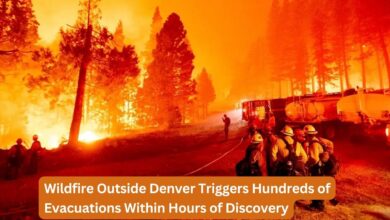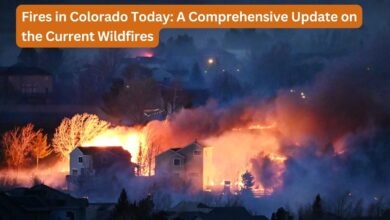Colorado Forest Fires, Climate Change, and River Health

Introduction: The Summer of Devastation
For the residents of Colorado, the summer of 2020 is a haunting memory. As the world grappled with the COVID-19 pandemic, Colorado faced another crisis: unprecedented wildfires. Thick ash blanketed neighborhoods like snow, skies turned ominously red, and the relentless advance of flames became a grim reality plastered across news platforms. This article explores the historic wildfires of 2020, their connection to climate change, and the profound impact on river health in Colorado.
Colorado Wildfires Claim a Place in History
Record-Breaking Fires
The summer of 2020 saw Colorado endure the three largest wildfires in its recorded history: the Cameron Peak Fire, the East Troublesome Fire, and the Pine Gulch Fire. The sheer scale of these fires produced staggering damage and left an indelible mark on the state’s landscape.
- Cameron Peak Fire: Scorching 208,913 acres across the Arapaho and Roosevelt National Forests and Rocky Mountain National Park, this fire became the largest in Colorado’s history.
- East Troublesome Fire: This fire burned 193,812 acres, devastating the Grand Lake area and forcing unprecedented evacuations.
- Pine Gulch Fire: Covering 139,007 acres, this fire wreaked havoc in Mesa and Garfield counties.
The Role of Climate Change
Rising Temperatures and Dry Conditions
The severity and frequency of wildfires in Colorado have been exacerbated by climate change. Rising temperatures, prolonged droughts, and unpredictable weather patterns have created conditions ripe for fires to ignite and spread rapidly.
- Temperature Increases: Colorado has experienced significant temperature rises over the past few decades. Warmer temperatures dry out vegetation, making forests more susceptible to fires.
- Drought: Extended periods of drought have reduced moisture levels in soil and vegetation, creating a tinderbox effect. When a fire ignites, it finds plenty of dry fuel to sustain and expand.
Human Activity and Forest Management
Human activities, such as land development and insufficient forest management practices, have also contributed to the increased risk of wildfires. Urban expansion into forested areas has heightened the chances of accidental ignitions, while historical practices of fire suppression have led to dense forests with high fuel loads.
Impact on River Health
Sedimentation and Water Quality
Wildfires have a profound impact on river health. The intense heat from fires can alter soil properties, making it hydrophobic, which increases runoff during rainstorms. This runoff carries ash, debris, and sediments into rivers, degrading water quality and disrupting aquatic ecosystems.
- Sediment Load: Increased sedimentation can smother fish habitats, disrupt spawning grounds, and reduce water clarity.
- Nutrient Imbalance: The influx of ash and nutrients can lead to algal blooms, which deplete oxygen levels in the water and harm aquatic life.
Temperature Changes
The removal of forest canopy by fires exposes streams and rivers to direct sunlight, leading to elevated water temperatures. Warmer water holds less oxygen, which can stress or kill fish and other aquatic organisms. Species that are particularly sensitive to temperature changes, such as trout, are at heightened risk.
Long-Term Ecological Effects
Forest Regeneration and Biodiversity
The aftermath of wildfires can lead to significant changes in forest composition and biodiversity. While fires are a natural part of many forest ecosystems, the intensity and frequency of recent fires pose challenges for natural regeneration.
- Tree Mortality: High-intensity fires can kill mature trees and alter the species composition of forests. Some species may struggle to regenerate in the altered post-fire environment.
- Wildlife Displacement: The destruction of habitats forces wildlife to relocate, which can lead to increased competition for resources and affect population dynamics.
Soil Health and Erosion
Post-fire landscapes are prone to erosion due to the loss of vegetation that stabilizes the soil. This erosion can lead to further degradation of river systems and create challenges for reforestation efforts.
Mitigation and Adaptation Strategies
Forest Management Practices
Improving forest management practices is crucial to mitigating the impact of wildfires. Strategies include controlled burns, thinning dense forests, and creating firebreaks to reduce fuel loads and prevent the spread of fires.
- Controlled Burns: These are intentional, low-intensity fires set under controlled conditions to reduce the amount of combustible material in forests.
- Thinning: Removing excess vegetation and smaller trees can decrease the intensity of potential fires.
Community Preparedness and Response
Communities in fire-prone areas need to be prepared for wildfire events. This includes developing emergency response plans, building fire-resistant infrastructure, and educating residents about fire safety.
- Emergency Plans: Having clear evacuation routes and communication strategies can save lives during a wildfire.
- Fire-Resistant Building Materials: Using materials that are less likely to ignite can help protect homes and structures.
Conclusion: A Call to Action
The wildfires that ravaged Colorado in 2020 are a stark reminder of the growing threat posed by climate change and the need for proactive measures to protect our environment. By understanding the connections between wildfires, climate change, and river health, we can take steps to mitigate these impacts and build more resilient ecosystems. Addressing these challenges requires a collective effort from governments, communities, and individuals to implement sustainable practices and reduce our carbon footprint.




